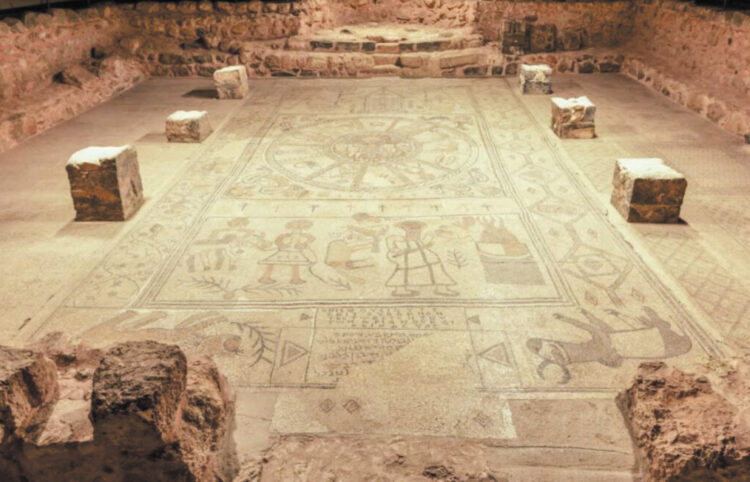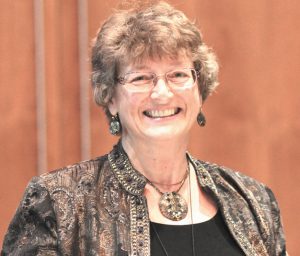Heaven on Earth

Considering Creation Series
Jewish Family Education with Candace R. Kwiatek, The Dayton Jewish Observer
In 1928, settlers at Kibbutz Beit Alpha were draining the swamps in the Jezreel Valley when they spotted mosaic shards. Excavations unearthed a fifth-century synagogue complex with a nearly perfectly preserved floor mosaic. The middle panel was as unexpected as it was breathtaking: a zodiac wheel with the 12 symbols labeled in Hebrew, a central sun figure driving a chariot among the moon and stars, and the four seasons as female figures in the corners.
From synagogue imagery to the timing of festivals, holidays, and Shabbat, to the earliest verses of Genesis, the celestial bodies play a significant role in Jewish thought and tradition.
“God said, ‘Let there be lights in the expanse of the sky to separate day from night; they shall serve as signs for the set times — the days and the years; and they shall serve as lights in the expanse of the sky to shine upon the earth.’ And it was so. God made the two great lights, the greater light to dominate the day and the lesser light to dominate the night, and the stars. And God set them in the expanse of the sky to shine upon the earth, to dominate the day and the night, and to separate light from darkness. And God saw how good this was. And there was evening and there was morning, a fourth day (Gen. 1:14-19).”
Long before modern science, the sages of the Gemara asked the obvious question: If light was created on the first day, how can it be that the sun, moon, and stars were set in the sky on the fourth day?
Some concluded the divine light of the first day was not that of the sun but a different kind of light.
Others asserted that the light was the same, but the luminaries themselves were not stabilized or suspended in their designated places in the firmament until the fourth day.
The medieval philosopher Rashi added that all the potentials of heaven and Earth were created on the first day, but each was set in place on the day when it was so commanded.

Despite their literary style, the early rabbinic explanations correlate remarkably well with today’s scientific knowledge.
Modern cosmology’s widely accepted Big Bang theory suggests the primordial elements of everything in the universe were all there at the first moment.
The pattern of darkness followed by visible light in the universe’s early ages was generated by changes in cosmic temperatures, atomic structures, and radiation wavelengths, and only eons later by the formation of stars and galaxies, according to science journalist Charles Choi.
As our own solar system emerged, the primeval atmosphere of Earth was an opaque, methane-dominated fog bathed in both cosmic microwave background radiation and light from the sun and moon.
From Earth’s vantage point, however, the individual celestial lights would have been indistinguishable until chemical changes in the atmosphere transformed it into a transparent sky, making it appear that the sun, moon, and stars were newly suspended in place.
At first glance, the fourth day’s text seems only to explain the three roles of the Earth’s luminaries as sources of light, visible dividers between day and night, and signs to indicate time. These functions certainly match the daily rhythm of light and darkness, the annual cycles of months and seasons, and the timing of Jewish rituals.
But a second look unearths some revolutionary ideas. The text is clear: the sun, moon, and stars neither created nor control light or time.
In the beginning, God created light and darkness, initiated and took control of time, and fashioned the celestial lights and their tasks.
Earth’s luminaries function only as anonymous servants that provide light, signal the rhythms of life, and serve as humans’ timekeepers. Just like that, the ancient deities of the sky were dethroned.
The limited roles of the sun, moon, and stars further stripped away the ancient belief that the celestial lights directed fate and fortune, events in the natural world, even a person’s life and character.
“The stars in particular are practically ignored,” biblical scholar Nachum Sarna notes, “a silence that is a (clear) repudiation of astrology!”
And yet, what about Beit Alpha, one of seven ancient synagogues in Israel with nearly identical floor mosaics? Abundant evidence suggests a mystical Jewish tradition, according to Israeli tour guide and author Walter Zanger.
From the synagogue entrance, Jewish worshipers symbolically climbed upward: across a mosaic panel depicting the merit of righteous ancestors, through the vortex of pagan images interpreted as reflections of God’s omnipotence, and onto a final “synagogue mosaic” filled with Jewish symbols, positioned right at the base of the Ark, the dwelling-place of the Torah. Revolutionary ideas turned into ritual.
A final revolutionary thought comes from Rabbi Joseph Soloveitchik. At a brit milah (ritual circumcision), the greater and lesser lights of Creation’s fourth day are invoked in the prayer, “May this small one become great.”
Soloveitchik explains that, like the moon, the infant is small because it can only reflect what it receives from others.
But we pray that the child will grow up to become great like the sun, an independent source of light who will enlighten others. That would be heaven on Earth.
Literature to share
Can Robots Be Jewish? And other pressing questions of modern life by Amy Schwartz, ed. In this anthology of Ask the Rabbi columns from Moment Magazine, editor Amy Schwartz highlights the breadth, wisdom, and creativity of Jewish thinking about the modern world. Rabbis spanning 10 denominations from Humanist to ultra-Orthodox offer brief but substantive responses to questions about editing genes, using social media, racism, happiness, belief in God, and more. Read it all the way through or savor it question by question.
Honey on the Page: A Treasury of Yiddish Children’s Literature by Miriam Udel, editor and translator. This children’s anthology offers engaging new translations of familiar and littleknown tales and poems from across the Yiddish-speaking world of the 20th century. Holidays and heroes, folktales and fools, and more can be found in this extensive collection, highlighted by delightfully whimsical illustrations. Children, families, and teachers will enjoy exploring Judaism’s unique Yiddish culture through its literature in this volume.
To read the complete February 2021 Dayton Jewish Observer, click here.


